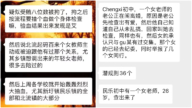【新唐人2013年12月04日訊】中共第五代領導人上任後,由於對地方債務的擔憂,已責令地方政府債務治理工作組到各地調查。而統計署上報國務院地方債務最新數據,已經將近50天,中共新政卻遲遲沒有對外公布,引發國內外專家和機構高度關注。外界質疑,統計署最新公布的地方債務數字之驚人,可能使中共新政不知所措。
10月20號,中共審計署向國務院匯報了地方債務最新規模,對於剛剛出爐的數字,社會各界,包括外國金融機構都頗為期待。但是直到今天,審計署也沒有向外界公布結果,引起各界的廣泛猜測。
11月中旬,國際評級機構「穆迪」,向中共財政部金融司商討地方債問題,但是到目前為止,中國的地方債務數據,還是難以獲得。
11月30號,中共官媒《新華網》發表文章聲稱,地方債測算的兩個主要部門——財政部和審計署,一直以來因為統計口徑的不同,測算結果也存在差異,統計結果還沒有確定,難以公布。
美國南卡羅萊納大學艾肯商學院教授謝田:「我想這個數字沒甚麼值得擔憂的話,中共它也不害怕公布,不是很危險的話, 中共甚至不會派工作組下去調查,如果公布出來是20萬億,甚至更多,會產生非常大的恐慌,如果就不公布的話,顯然面臨著國內外巨大的壓力,人們都在問它為甚麼不公布,公布一個虛假的數字的話, 等於把它自己跟它前任的造假捆綁在了一起。」
今年初,在社科院舉辦的地方政府信用評級研討會上,社科院金融研究所研究員劉煜輝估計,目前中國的地方債務 「黑洞」已經突破20萬億元。
大陸《財新網》10月16號報導,「渣打銀行」發佈研究報告,預計中國地方政府性債務總額可能超過24萬億元。
而12月3號,中國《財經網》,引述「國家信息中心經濟預測部」首席經濟師祝寶良的話說,他所在的機構通過測算顯示,中國地方政府債務規模約為20萬億。
大陸金融分析師任中道:「20萬億也好,24萬億也好,都佔到了GDP的一半,就是說產生出100塊錢的價值, 50塊錢這個債務是不算數的。那就是說,中國的民眾他的努力產生出來的價值是去還債了,讓中共給用了。」
大陸企業觀察員何軍樵:「這個政黨和這個政府所有的數據都是保密的,很難確定它的地方債務到底是多少,我們只能從某些資金市場去推測,前一段時間銀行的錢荒也表明瞭這樣一個問題,各級地方政府對自己的債務是多少,估計他們能搞得清,至於中央能不能搞得清,我都表示懷疑,經濟學家或有關金融專家他們能不能搞得清,我也表示懷疑。」
審計署上一次公布全國地方債務數據,是2011年6月,審計結果顯示,截至2010年底,全中國地方政府性債務餘額超過10萬7千億人民幣。
就在當時,審計署公布數據不過十天,「穆迪」便發表報告指出,中國地方政府債務負擔,可能比審計估算數字多出3萬5千億。
對此,剛參與完查賬工作的某地方財政局人士對《新華網》表示,此次審計署查賬工作主要是基於2011年的增量情況做出統計。這位人士還表示,從中央到地方沒有一套完整的風險預警機制,而平時設立的一套用來應付審計檢查的方法,一定程度上誤導了審計,導致債務規模難以統計。
任中道:「地方政府很多借債都是從銀行貸款出來的,如果地方債發生了債務違約,銀行就產生了壞賬呆賬,幾十萬億的呆賬,會讓整個銀行系統可能就是崩潰的狀態,中國民眾的錢存銀行現在都不安全。」
美國《紐約時報》指出,一旦中國經濟出現下行,地方政府的高負債必然會成為中國經濟的隱患,最後引發債務危機。
採訪編輯/劉惠 後製/陳建銘
The CCP Faces The Latest Local Debt Dilemma
Upon taking the office, the fifth generation of CCP leaders
has ordered local task forces to compile information on
local debts.
It’s been nearly 50 days since the new data collected by the
National Audit Office was presented to the State Council,
yet the information remains unavailable to the public.
Experts and institutes both domestic and foreign have shown
their concern and suspect that the overwhelming data
has caused a dilemma for the new leadership.
On Oct. 20, the CCP national audit office reported the latest
local debts to the State Council.
Various sectors and foreign financial institutions have
anticipated the results, yet they still haven’t been made public,
and people are wondering why.
Even though the international credit rating agency Moody’s
made an inquiry on the local debts data in mid November,
the has data remained a mystery.
On Nov. 30, CCP official media Xinhua reported that
data publication has been delayed because of variations
in data analysis due to different statistic standards employed
by the Ministry of Finance and the National Audit Office,
and thus the result is yet to be concluded.
Xie Tian, business professor at University of South
Carolina Aiken: “I believe if there the data was nothing to
worry about, the CCP would have published it already.
If it weren’t a crisis, the CCP wouldn’t have assigned
a task force for the investigation.
If the debts are 20 trillion or more,
it will create a greater panic.
If they don’t publish it, they will obviously face greater
pressure from both at home and abroad asking
why the data is not released.
If they release a false figure, they will tie themselves with
the fraud of their predecessors."
Earlier this year the Chinese Academy of Social Sciences
organized a local government credit ratings forum.
Liu Yuhui, Institute of Finance and Banking researcher at
CASS reported that local debts exceed 20 trillion yuan
($3.3 trillion).
In an Oct. 16 Caixin.com report, Standard Chartered Bank
estimated China’s local debts have exceeded 24 trillion yuan
($3.9 trillion).
On Dec. 3, Caijing.com quoted Zhu Baoliang, chief economist
of economic forecasting department, State Information Center,
saying that China’s local government debt is about 20 trillion.
Ren Zhongdao, financial analyst: “20 trillion or 24 trillion
yuan, either way it’s half of the GDP.
That means for every $100 made, $50 is for the debts.
That is to say, half of what the people have produced is used
by the CCP to pay the debts."
He Junqiao, mainland China enterprises observer:
“The Party and it’s regime’s data is all confidential.
It is difficult to determine the exact amount of local debt.
We can only speculate from the market.
The bank’s money shortage that happened not long ago
also had the same issue.
Local governments know exactly how much they owe.
As for the central, I doubt if they have a clear picture of it.
I am also skeptical of whether economists
or financial experts can really know the details."
According to the national audit in June 2011,
by the end of 2010, the total local government debt balance
was over 10.7 trillion yuan ($1.76 trillion).
10 days after the official report, a report published by
Moody’s indicated that Chinese local government debt may be
3.5 trillion yuan ($540 billion) higher than the Chinese data.
A local finance bureau official who participated in the audit
told to Xinhua that the Chinese data
was based on 2011 increments.
The official also said that due to the lack of a comprehensive
risk warning mechanism from the central to local,
the conventional audit tends to mislead the analysis to
some extent, and thus the total debts become a difficult task.
Ren Zhongdao: “Many local governments borrow through
bank loans.
Any default on a loan will result in bad debt for the bank.
A bad debt of tens of trillions of yuan could result in
the collapse of the entire banking system.
Keeping money in the bank is not safe for the Chinese now."
The New York Times Chinese reports that
once the Chinese economy is down,
high local debts will inevitably pose risk to China’s economy,
and finally lead to a debt crisis.
Interview & Edit/LiuHui Post-Production/ChenJianming




























